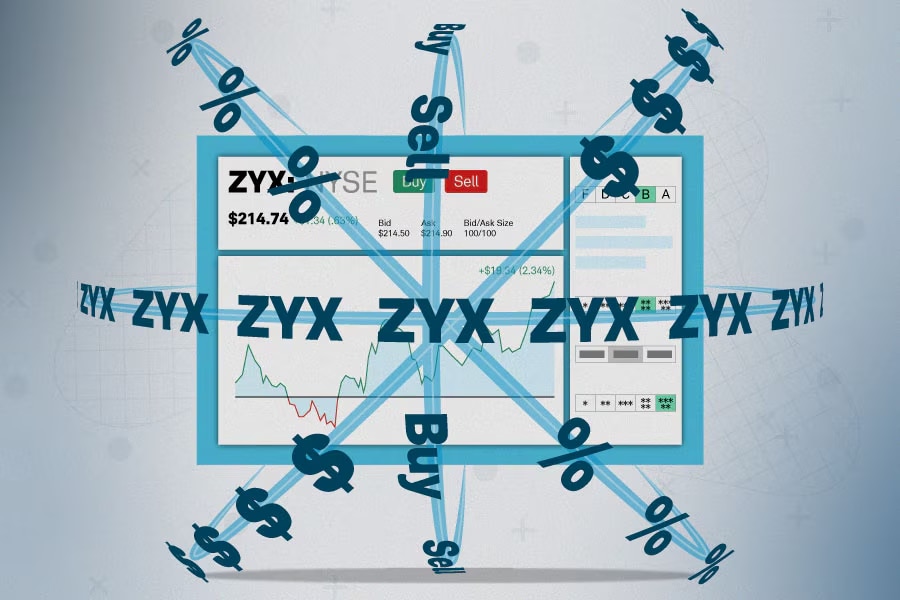Stocks Flat Ahead of Shortened Trading Session

Published as of: December 24, 2025, 9:07 a.m. ET
Listen to this article
Listen here or subscribe for free to the Schwab Market Update in your favorite podcast app.
| The markets | Last price | Change | % change |
|---|---|---|---|
| S&P 500® index | 6,909.79 | +31.30 | +0.46% |
| Dow Jones Industrial Average® | 48,442.41 | +79.73 | +0.16% |
| Nasdaq Composite® | 23,561.84 | +133.02 | +0.57% |
| 10-year Treasury yield | 4.16% | -0.10 | -- |
| U.S. Dollar Index | 97.91 |
-0.29 |
-0.29% |
| Cboe Volatility Index® | 13.96 | -0.04 | -0.29% |
| WTI Crude Oil | $58.51 | +$0.12 | +0.21% |
| Bitcoin | $87,130 | -$555 |
-0.63% |
(Editor's note: Due to the 1:00 p.m. ET market close, today's Schwab Market Update is an abbreviated version. For late-breaking market news, please tune in to the Schwab Network, which will be broadcasting today from 8 a.m. until 1 p.m. ET.).
(Wednesday market open) Stocks had barely budged heading into the holiday-shortened trading session, though investors have plenty to cheer about as the major indexes sit at or near record highs and the U.S. economy continues to outperform expectations.
Today marks the "official" beginning of the "Santa Claus rally" period, which covers the final five trading days of the year and the first two of the new year. Markets tend to rise during this period, but if it happens this year it'll be the first time in three years. Markets will close today at 1 p.m. ET and will remain closed for the Christmas holiday tomorrow.
On Tuesday, Nvidia (NVDA) and Broadcom (AVGO) led a tech rally that pushed markets higher for a fourth consecutive day, with the S&P 500 closing at a record high. The Dow and Nasdaq also rose. Trading volume was thin. The market was also bolstered by the release of a delayed report showing stronger-than-expected economic growth in the third quarter. The 10-year Treasury yield ticked up to 4.17% as the stronger growth caused some to reconsider expectations for Federal Reserve rate cuts. Gold and silver again hit all-time highs.
To get the Schwab Market Update in your inbox every morning, subscribe on Schwab.com.
Three things to watch
- GDP growth, consumer spending prompt rate-cuts rethink: The unexpectedly strong economic growth reported for the third quarter, driven by robust consumer spending, is prompting a mild recalibration of expectations for interest rate cuts by the Federal Reserve in the coming year. Futures trading now points to a 13.3% chance of a cut in January, down from 19.9% a day earlier, and a 40.7% chance in March, down from 44.7% a day earlier. The Fed's rationale for recent rate cuts has focused on weakness in the labor market at a time when inflation, though above its target, was seen as a lesser threat. "I think this gives the Fed a little bit more time," said Collin Martin, head of fixed-income research and strategy, Schwab Center for Financial Research. "It allows them to be patient going forward, and I think this kind of offsets the little bump in the unemployment rate, which kind of spooked the market in terms of Fed expectations."
- Two releases, two views of consumers: Data from the Bureau of Economic Analysis on Tuesday showed that consumer spending rose 3.5% in the third quarter, the biggest increase in three quarters, driving the fastest economic growth in two years. Later, the Conference Board's consumer confidence survey found consumers' relatively grim mood had gotten worse. Their views of current business and labor market conditions tumbled, while views of their family's current financial situation fell into negative territory for the first time in nearly four years. The survey also found that consumers were turning more cautious about buying big-ticket items over the next six months, with fewer planning to do so. What explains the disconnect? The K-shaped economy could explain it. A six-month moving average of confidence fell for nearly all income groups, according to the Conference Board. One exception: those earning more than $125,00 a year.
- The 'fear gauge' shows investors feeling just fine: Traders apparently see little fear heading into the year's end. The S&P 500 marked another record high Tuesday, while the Cboe Volatility Index (VIX), otherwise known as the "fear gauge," hit the lowest intraday level since December 13 last year. Stocks have been choppy in recent weeks as some investors rotated out of tech, but they've held up pretty well overall. Meanwhile, the VIX has drifted lower as investors have grown more comfortable. It's down about 50% from levels seen just a month ago, on November 20. It still has further to fall before it reaches an extreme level of comfort that contrarians could read as complacency. But it's seen a dramatic decline as stocks staged a remarkable recovery following the harsh April selloff driven by President Trump's tariff announcements. That news sent the VIX to the second-highest level since March 2020, during the initial outbreak of COVID-19.
On the move
Nike (NKE) rose more than 2% in early trade after Apple (AAPL) CEO Tim Cook, a Nike board member, bought nearly $3 million worth of Nike shares.
Intel (INTC) fell almost 3% after Reuters reported thatNvidia recently tested Intel's 18A manufacturing process but stopped moving forward.
ServiceNow (NOW) confirmed its $7.75B acquisition of cybersecurity firm Armis, earning encouraging remarks from William Blair, Citi, and Raymond James. NOW shares are slightly lower ahead of the open.
More insights from Schwab

Reading between the lines: A stock's price reflects far more than what investors are willing to pay for its shares. To understand what really shapes a stock's price, check out Schwab's guide to reading stock quotes.
The week ahead
December 25: No major earnings or data expected. U.S. markets closed for Christmas holiday.
December 26: No major earnings or data expected.
December 29: Pending U.S. home sales.
December 30: No major earnings or data expected.
December 31: EIA crude oil inventories.